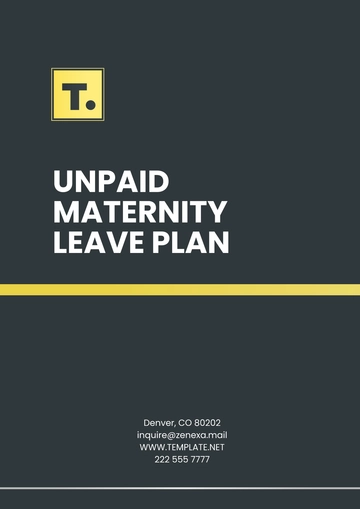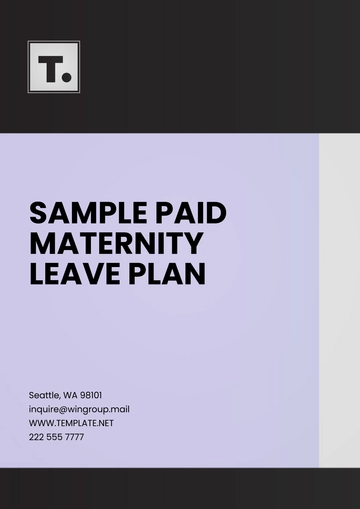Free Postpartum Recovery Leave Plan

Prepared by: [Your Name]
Company: [Your Company Name]
Date: [Date]
1. Introduction
The Postpartum Recovery Leave Plan is designed to support employees during their recovery and transition back to the workplace after childbirth. This plan balances personal recovery with professional responsibilities, promoting employee well-being and maintaining a supportive and inclusive work environment.
2. Eligibility
The postpartum recovery leave is available to all employees who have experienced childbirth, including those who have become parents through surrogacy or adoption (as applicable). To be eligible, employees must meet the following criteria:
Employment Status: Must be a full-time or part-time employee with at least six months of continuous service.
Medical Documentation: Must provide appropriate medical documentation from a certified healthcare provider to confirm the need for postpartum recovery leave.
Job Protection: Employees on approved postpartum recovery leave are guaranteed job protection for the duration of the leave as per applicable local and federal laws.
3. Leave Duration and Extensions
The standard postpartum recovery leave is up to 12 weeks. Extensions beyond this period may be considered based on medical recommendations and managerial approval. Employees requesting extensions should:
Submit a request for an extension before the expiration of the initial leave period.
Provide additional medical documentation from a healthcare provider indicating the need for an extended recovery period.
4. Application Process
To ensure a smooth transition, employees should follow these steps when requesting postpartum recovery leave:
Advance Notice: Submit a written request at least four weeks in advance where possible, outlining:
Expected date of leave commencement.
Expected duration of leave.
Medical documentation from a healthcare provider.
Documentation: Employees may be required to provide ongoing medical updates for extended leave requests or in the case of any unforeseen complications.
Employees are encouraged to discuss the leave with their immediate supervisor and Human Resources well in advance to allow for proper planning.
5. Benefits and Compensation
During postpartum recovery leave, employees are entitled to continued benefits as outlined below:
5.1 Financial Compensation
Paid Leave: Employees will receive their regular pay during the leave, subject to the organization’s policies, including any eligibility requirements for paid leave, such as the availability of paid time off (PTO) or other leave entitlements.
Unpaid Leave Option: If paid leave is not available, employees may be eligible for unpaid leave with job protection, ensuring their role remains available upon return.
5.2 Health Benefits
Continued Coverage: Healthcare benefits, including medical, dental, and vision coverage, will continue uninterrupted during the postpartum leave period.
Flexible Benefits: Employees will retain access to benefits such as Employee Assistance Programs (EAP) and other wellness programs throughout the leave.
5.3 Other Benefits
Retirement Contributions: Employees will continue to receive contributions toward their retirement plans (such as 401(k)) during paid leave, as per company policies.
6. Return to Work
We understand the importance of a smooth transition back to the workplace after recovery. To assist with reintegration, the following guidelines are provided:
6.1 Return-to-Work Notification
Employees are encouraged to notify their supervisor and HR department at least two weeks before their planned return date. This ensures appropriate planning for their re-entry.
6.2 Transitional Support
To support employees as they transition back to work, the company offers the following options:
Flexible Working Hours: Employees may request flexible working hours to ease their return to the workplace.
Remote Work Options: Employees may be eligible for remote work arrangements, based on the nature of their role.
Part-Time Options: If desired, employees may return to work on a part-time basis for a short period before transitioning to full-time.
6.3 Workplace Accommodations
The organization is committed to providing workplace accommodations for new parents, including ergonomic adjustments to workstations, private spaces for breastfeeding, and other necessary accommodations as per company policy and local law.
7. Employee Support and Resources
We offer several resources to ensure employees feel supported during their postpartum recovery:
7.1 Employee Assistance Program (EAP)
Counseling and Support: EAP services provide confidential counseling and support to employees dealing with emotional, psychological, or physical challenges during recovery.
7.2 Workshops and Support Groups
Parenting Workshops: Regular workshops on parenting, mental health, and wellness to assist employees in balancing work and home life after childbirth.
Support Groups: Peer-led support groups where new parents can connect and share experiences, helping each other adjust to their new roles.
7.3 Additional Resources
Childcare Assistance: In some cases, the company may assist with resources or referrals for childcare services.
Lactation Support: The organization offers private lactation spaces for employees who are breastfeeding and require accommodations for lactation during work hours.
8. Job Protection and Anti-Discrimination
The organization affirms that:
Job Security: Employees on postpartum leave are entitled to return to their same position or an equivalent position, without penalty or loss of seniority.
Non-Discrimination: The organization does not tolerate discrimination against employees due to pregnancy, childbirth, or related medical conditions. All policies related to parental leave are in full compliance with applicable discrimination and family leave laws.
9. Conclusion
The Postpartum Recovery Leave Plan is a cornerstone of our commitment to employee well-being and work-life balance. This plan ensures that employees can focus on their recovery and family life while knowing their professional needs are supported. The organization remains dedicated to providing the resources and accommodations necessary to facilitate a smooth and successful transition back to work.
- 100% Customizable, free editor
- Access 1 Million+ Templates, photo’s & graphics
- Download or share as a template
- Click and replace photos, graphics, text, backgrounds
- Resize, crop, AI write & more
- Access advanced editor
Streamline your FMLA leave planning with Template.net’s professionally designed U.S.-specific FMLA Leave Plan Template. Fully customizable and editable, this template ensures compliance and clarity. Effortlessly personalize it using our intuitive Ai Editor Tool. Save time and create a polished document tailored to your needs. Simplify leave management today with this easy-to-use, reliable solution!
You may also like
- Finance Plan
- Construction Plan
- Sales Plan
- Development Plan
- Career Plan
- Budget Plan
- HR Plan
- Education Plan
- Transition Plan
- Work Plan
- Training Plan
- Communication Plan
- Operation Plan
- Health And Safety Plan
- Strategy Plan
- Professional Development Plan
- Advertising Plan
- Risk Management Plan
- Restaurant Plan
- School Plan
- Nursing Home Patient Care Plan
- Nursing Care Plan
- Plan Event
- Startup Plan
- Social Media Plan
- Staffing Plan
- Annual Plan
- Content Plan
- Payment Plan
- Implementation Plan
- Hotel Plan
- Workout Plan
- Accounting Plan
- Campaign Plan
- Essay Plan
- 30 60 90 Day Plan
- Research Plan
- Recruitment Plan
- 90 Day Plan
- Quarterly Plan
- Emergency Plan
- 5 Year Plan
- Gym Plan
- Personal Plan
- IT and Software Plan
- Treatment Plan
- Real Estate Plan
- Law Firm Plan
- Healthcare Plan
- Improvement Plan
- Media Plan
- 5 Year Business Plan
- Learning Plan
- Marketing Campaign Plan
- Travel Agency Plan
- Cleaning Services Plan
- Interior Design Plan
- Performance Plan
- PR Plan
- Birth Plan
- Life Plan
- SEO Plan
- Disaster Recovery Plan
- Continuity Plan
- Launch Plan
- Legal Plan
- Behavior Plan
- Performance Improvement Plan
- Salon Plan
- Security Plan
- Security Management Plan
- Employee Development Plan
- Quality Plan
- Service Improvement Plan
- Growth Plan
- Incident Response Plan
- Basketball Plan
- Emergency Action Plan
- Product Launch Plan
- Spa Plan
- Employee Training Plan
- Data Analysis Plan
- Employee Action Plan
- Territory Plan
- Audit Plan
- Classroom Plan
- Activity Plan
- Parenting Plan
- Care Plan
- Project Execution Plan
- Exercise Plan
- Internship Plan
- Software Development Plan
- Continuous Improvement Plan
- Leave Plan
- 90 Day Sales Plan
- Advertising Agency Plan
- Employee Transition Plan
- Smart Action Plan
- Workplace Safety Plan
- Behavior Change Plan
- Contingency Plan
- Continuity of Operations Plan
- Health Plan
- Quality Control Plan
- Self Plan
- Sports Development Plan
- Change Management Plan
- Ecommerce Plan
- Personal Financial Plan
- Process Improvement Plan
- 30-60-90 Day Sales Plan
- Crisis Management Plan
- Engagement Plan
- Execution Plan
- Pandemic Plan
- Quality Assurance Plan
- Service Continuity Plan
- Agile Project Plan
- Fundraising Plan
- Job Transition Plan
- Asset Maintenance Plan
- Maintenance Plan
- Software Test Plan
- Staff Training and Development Plan
- 3 Year Plan
- Brand Activation Plan
- Release Plan
- Resource Plan
- Risk Mitigation Plan
- Teacher Plan
- 30 60 90 Day Plan for New Manager
- Food Safety Plan
- Food Truck Plan
- Hiring Plan
- Quality Management Plan
- Wellness Plan
- Behavior Intervention Plan
- Bonus Plan
- Investment Plan
- Maternity Leave Plan
- Pandemic Response Plan
- Succession Planning
- Coaching Plan
- Configuration Management Plan
- Remote Work Plan
- Self Care Plan
- Teaching Plan
- 100-Day Plan
- HACCP Plan
- Student Plan
- Sustainability Plan
- 30 60 90 Day Plan for Interview
- Access Plan
- Site Specific Safety Plan




















